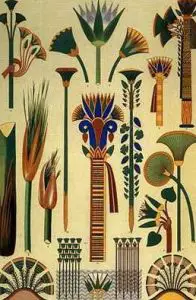Many of the plants were used to the Egyptians, some as food, others for their medicinal qualities, and a few for their beauty. Egyptian Plants such as lotus and papyrus were very common in Egypt. During the pharaonic period, the papyrus (Cyperus papyrus) grew in thickets with considerable fauna along the Nile.
To the Egyptians, the papyrus became the symbol of fertility and life itself. Therefore, the theme of papyrus stalks with their sweeping flower umbels was the most commonly used plant decoration used in stylized architecture and many other objects. Egyptians grew crops such as wheat, barley, vegetables, figs, melons, pomegranates, and vines. They also grew flax which was made into linen.

Many Egyptian plants were sacred to them and treated as Plant Gods. Some of these are the palm-tree that shaded them amid the desert, the spring that gave them drink in the oasis, the grove where they could meet and rest and the sycamore flourishing miraculously in the sand.
The practice of providing the mummy of the deceased with a fresh garland of flowers developed at the beginning of the New Kingdom. Unfortunately, the floral collar found on the mummy of Tutankhamen is the only extant example of these.
However, from that collar, we can surmise that the method of manufacture and the plant material incorporated within the collar is very similar to those used at banquets. It rested on the chest area of the innermost of his three coffins. Other plants were also used in the funerary process. For example, bulb leaves from a Crinum variety, which is not indigenous to Egypt, were used to cover the eyes, nose, mouth and mummification incisions of one mummy.
Water from the Nile makes it possible to grow crops in Egypt, especially grain (wheat and barley) and beans (like lentils or chickpeas). Every June, the Nile flooded. This was known as the flooding season. During this time the farmers would mend tools or make new ones. People would go fishing for food or extra money.
Some of the plants in ancient Egypt had medicinal properties. Coriander Oil has been shown to have mild anti-bacterial properties and moderate anti-inflammatory actions if applied locally. Modern research has shown that a hot water extract of Matricaria chamomile has an antibacterial effect. Garlic’s medicinal properties have long been recognized, some say the pyramids could not have been built without it.